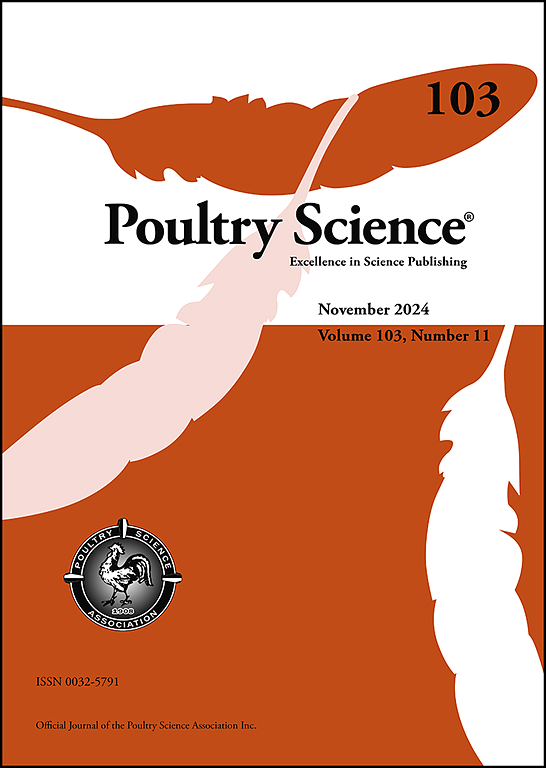IF 3.8
1区 农林科学
Q1 AGRICULTURE, DAIRY & ANIMAL SCIENCE
引用次数: 0
摘要
我们以前的研究表明,在肉鸡早期喂食蚯蚓(EW)可以减轻可溶性非淀粉多糖(NSP)引起的日粮挑战。然而,提供蚯蚓的积极作用是否与肉鸡肠道微生物群落的变化有关,这一问题尚未得到研究。本后续研究调查了提供 EW 和蛭石堆肥(VC)对肉鸡肠道微生物群多样性的影响,即以标准玉米-大豆日粮为阳性对照(CON+)或以富含 NSP 的日粮为阴性对照(CON-)。共对 120 只新孵化的 Cobb-500 基因型雄鸡进行了两个阶段(P)的研究,每个阶段持续 8 天。在 P1 期,鸟类被分为四组:两组接受 CON+ 日粮(每组 30 只),第三组接受 CON+ 加 1 % EW 日粮(CON+EW,30 只),最后一组接受 CON+ 加 1 % VC 日粮(CON+VC,30 只)。在 P1 结束时,每组有一半的鸟被安乐死,并收集回肠消化物进行微生物群分析。在 P2 阶段,P1 阶段的 CON+ 组中有一组继续食用相同的食物,其余各组则改用 NSP 补充阴性对照 CON- (n = 15)、CON-EW(n = 15)或 CON-VC (n = 15)的食物。在 P2 结束时,对所有组中的剩余鸟类实施安乐死,以收集回肠消化液。使用 16S rRNA 基因测序评估微生物组成。在 P1 中,CON+VC 的 Chao1 指数明显高于 CON+ 和 CON+EW(P < 0.05)。在 P2 中,各组的 α 多样性指标保持不变(P < 0.05),但 CON+ 中的 Chao1 指数呈上升趋势(P = 0.078)。对 β 多样性的分析突显了 P2 饮食组间的显著差异(P = 0.001)。进一步分析确定了不同的富集菌属,发现在 P1 期间,肠球菌在 CON+ 组中很突出,而乳酸杆菌在 CON+EW 组中明显较多。在第二阶段,CON-EW 组的乳酸杆菌数量增加,而在 CON- 组中,埃希氏菌的比例过高。功能分析显示,CON-EW 和 CON-VC 日粮丰富了烟酰胺腺嘌呤二核苷酸生物合成和发酵成醋酸和乳酸的相关途径,而 CON- 则增加了肠杆菌素和气门杆菌素的生物合成。总之,膳食补充蚯蚓对肠道微生物群的组成和预测对膳食挑战的响应功能有积极影响。本文章由计算机程序翻译,如有差异,请以英文原文为准。
Modulation of early life gut microbiota through inclusion of earthworms and vermicompost in broiler diets
We previously showed that providing earthworms (EW) to broilers during early life can mitigate dietary challenges induced by soluble non-starch polysaccharides (NSP). However, whether the positive effects of providing EW are associated with changes in the gut microbial communities of broilers was not studied. This follow-up study investigated the influence of providing EW and vermicompost (VC) on gut microbiota diversity in broilers fed either a standard corn-soy based diet as positive control (CON+) or a diet rich in NSP as negative control (CON-). A total of 120 newly hatched male birds of Cobb-500 genotype were examined in two periods (P), each lasting 8 days. In P1, birds were divided into four groups: two groups received the CON+ diet (n = 30 each), the third group received CON+ plus 1 % EW (CON+EW, n = 30), and the last group received CON+ supplemented with 1 % VC (CON+VC, n = 30). Half of the birds in each group were euthanized at the end of P1, and ileal digesta were collected for microbiota analysis. In P2, one of the CON+ groups from P1 continued the same diet, while the remaining groups were switched to dietary challenge either NSP supplemented negative control CON- (n = 15), or CON-EW (n = 15) or CON-VC (n = 15). At the end of P2, the remaining birds in all groups were euthanized for ileal digesta collection. Microbial composition was assessed using 16S rRNA gene sequencing. In P1, the CON+VC exhibited a significantly higher Chao1 index compared to the CON+ and CON+EW (P < 0.05). In P2, α-diversity metrics remained unchanged across groups (P < 0.05), although the Chao1 index in the CON+ showed a trend toward an increase (P = 0.078). Analysis of β-diversity highlighted significant differences between dietary groups in P2 (P = 0.001). Further analysis identified differentially enriched genera, revealing that Enterococcus was prominent in the CON+ during P1, while Lactobacillus was significantly higher in the CON+EW group. In P2, the CON-EW group exhibited increased Lactobacillus abundance while Escherichia-Shigella was overrepresented in the CON- group. Functional analysis showed that the CON-EW and CON-VC diets enriched the pathways related to Nicotinamide Adenine Dinucleotide biosynthesis and fermentation to acetate and lactate, whereas the CON- increased the biosynthesis of enterobactin and aerobactin. In conclusion, dietary earthworm supplementation positively influenced gut microbiota composition and predicted functions in response to dietary challenges.
求助全文
通过发布文献求助,成功后即可免费获取论文全文。
去求助
来源期刊

Poultry Science
农林科学-奶制品与动物科学
CiteScore
7.60
自引率
15.90%
发文量
0
审稿时长
94 days
期刊介绍:
First self-published in 1921, Poultry Science is an internationally renowned monthly journal, known as the authoritative source for a broad range of poultry information and high-caliber research. The journal plays a pivotal role in the dissemination of preeminent poultry-related knowledge across all disciplines. As of January 2020, Poultry Science will become an Open Access journal with no subscription charges, meaning authors who publish here can make their research immediately, permanently, and freely accessible worldwide while retaining copyright to their work. Papers submitted for publication after October 1, 2019 will be published as Open Access papers.
An international journal, Poultry Science publishes original papers, research notes, symposium papers, and reviews of basic science as applied to poultry. This authoritative source of poultry information is consistently ranked by ISI Impact Factor as one of the top 10 agriculture, dairy and animal science journals to deliver high-caliber research. Currently it is the highest-ranked (by Impact Factor and Eigenfactor) journal dedicated to publishing poultry research. Subject areas include breeding, genetics, education, production, management, environment, health, behavior, welfare, immunology, molecular biology, metabolism, nutrition, physiology, reproduction, processing, and products.
 求助内容:
求助内容: 应助结果提醒方式:
应助结果提醒方式:


